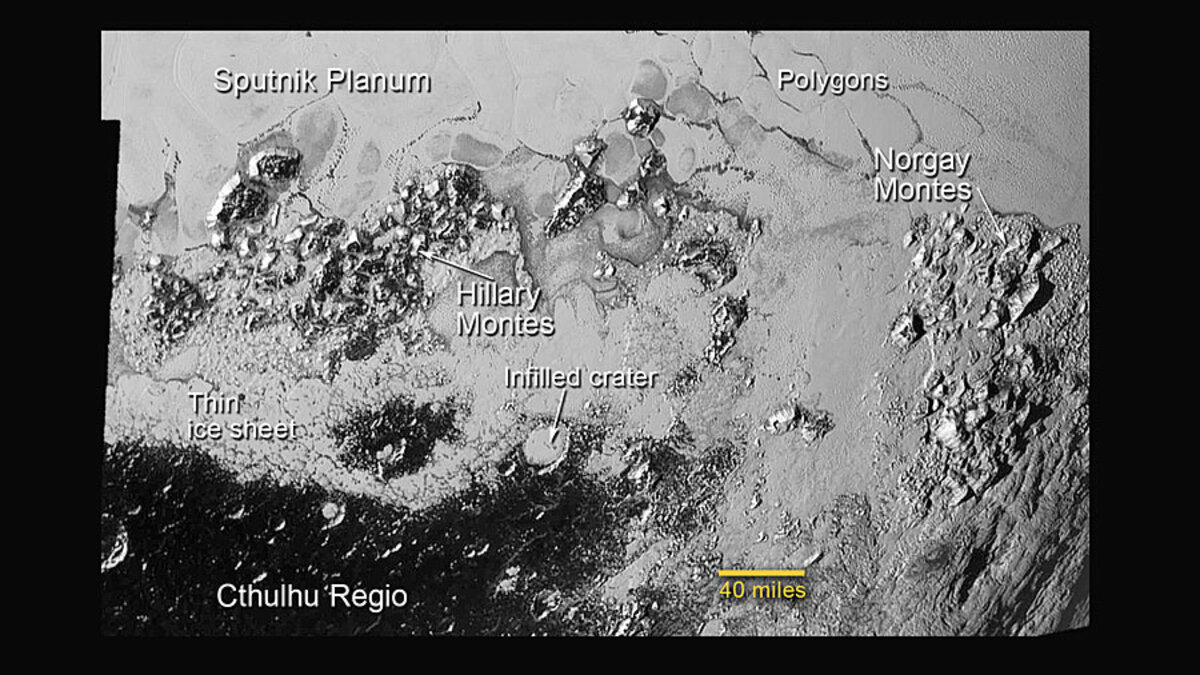Breathtaking Pluto images reveal icy dwarf planet's plains and mountains
Loading...
Until barely two weeks ago, Pluto tantalized humanity for eight decades with mysteries we could only imagine – seen as just a point of light or fuzzy blob in the world’s most powerful telescopes.
Now the last explored planetary system in our solar system is being revealed for the first time in history to human eyes, piece by piece, in the form of the highest resolution flyover mosaics and movies of the alien surface ever available, now and for decades to come.
And it’s all thanks to the brilliant efforts of the scientists and engineers leading NASA’s New Horizons mission – which culminated in the first ever close encounter with Pluto and its five moons by a spacecraft from Earth on July 14, 2015.
With the resoundingly successful close flyby completed and the piano shaped New Horizons probe now looking in the rear view mirror, the scientific booty is raining down on receivers back on Earth. However it will take about 16 months to send all the flyby science data back to Earth due to limited bandwidth.
The first series of seven breathtaking high resolution surface images focusing on Pluto’s bright heart-shaped region, informally named ‘Tombaugh Regio’, has been stitched together into our new and wider view mosaic, shown above and below.
Furthermore the New Horizons team has created a spectacular simulated flyover movie centered in the heart of Pluto’s huge ‘Heart’ at ‘Tombaugh Regio’, showing the stunning views including the incredibly recent ice flows and plains of ‘Sputnik Planum’ and monumental icy mountain ranges of ‘Norgay Montes’ and newly discovered ‘Hillary Montes.’
The mosaic and movie are compiled from the seven highest resolution images captured by NASA’s New Horizons LORRI imager during the history making closest approach flyby.
The LORRI images were taken from a distance of 48,000 miles (77,000 kilometers) from the surface of the planet about 1.5 hours prior to the closest approach at 7:49 a.m. EDT on July 14. The images easily resolve structures smaller than a mile across.
New Horizon’s unveiled Pluto as a surprising vibrant and geologically active “icy world of wonders” as it barreled past the Pluto-Charon double planet system on July 14 at over 31,000 mph (49,600 kph) and collected unprecedented high resolution imagery and spectral measurements of the utterly alien worlds.
The newly-discovered mountain range has been informally named Hillary Montes (Hillary Mountains) for Sir Edmund Hillary, who first summited Mount Everest with Tenzing Norgay in 1953. They rise about one mile (1.6 kilometers) above the surrounding plains, similar to the height of the Appalachian Mountains in the United States.
They are located nearby and somewhat north of another mountain range discovered first and named Norgay Montes (Norgay Mountains).
“For many years, we referred to Pluto as the Everest of planetary exploration,” said New Horizons Principal Investigator Alan Stern of the Southwest Research Institute, Boulder, Colorado.
“It’s fitting that the two climbers who first summited Earth’s highest mountain, Edmund Hillary and Tenzing Norgay, now have their names on this new Everest.”
Watch this flyover above Pluto’s icy plains at Sputnik Planum and Hillary Montes:
The LORRI images show “extensive evidence of exotic ices flowing across Pluto’s surface and revealing signs of recent geologic activity, something scientists hoped to find but didn’t expect.”
Sputnik Planum is a Texas-sized plain, which lies on the western, left half of Pluto’s bilobed and bright heart-shaped feature, known as Tombaugh Regio.
The new imagery and spectral evidence from the Ralph instrument appears to show the flow of nitrogen ices in geologically recent times across a vast region. They appear to flow similar to glaciers on Earth. There are also carbon monoxide and methane ices mixed in with the water ices.
“At Pluto’s temperatures of minus-390 degrees Fahrenheit, these ices can flow like a glacier,” said Bill McKinnon, deputy leader of the New Horizons Geology, Geophysics and Imaging team at Washington University in St. Louis.
“In the southernmost region of the heart, adjacent to the dark equatorial region, it appears that ancient, heavily-cratered terrain has been invaded by much newer icy deposits.”
“We see the flow of viscous ice that looks like glacial flow.”
As of today, July 26, New Horizons is 12 days past the Pluto flyby and already over 15 million kilometers beyond Pluto and continuing its journey into the Kuiper Belt, the third realm of worlds in our solar system.
New Horizons discovered that Pluto is the largest known body beyond Neptune – and thus reigns as the “King of the Kuiper Belt!”
The science team plans to target New Horizons to fly by another smaller Kuiper Belt Object (KBO) as soon as 2018.
Watch for Ken’s continuing coverage of the Pluto flyby. He was onsite reporting live on the flyby and media briefings for Universe Today from the Johns Hopkins University Applied Physics Laboratory (APL), in Laurel, Md.
Stay tuned here for Ken’s continuing Earth and planetary science and human spaceflight news.
Dr. Ken Kremer is a speaker, research scientist, freelance science journalist (Princeton, NJ) and photographer whose articles, space exploration images and Mars mosaics have appeared in magazines, books, websites and calendars including Astronomy Picture of the Day, NBC, BBC, SPACE.com, Spaceflight Now and the covers of Aviation Week & Space Technology, Spaceflight and the Explorers Club magazines. Ken has presented at numerous educational institutions, civic & religious organizations, museums and astronomy clubs. Ken has reported first hand from the Kennedy Space Center, Cape Canaveral, NASA Wallops, NASA Michoud/Stennis/Langley and on over 40 launches including 8 shuttle launches. He lectures on both Human and Robotic spaceflight - www.kenkremer.com. Follow Ken on Facebook and Twitter.
Originally published on Universe Today.







